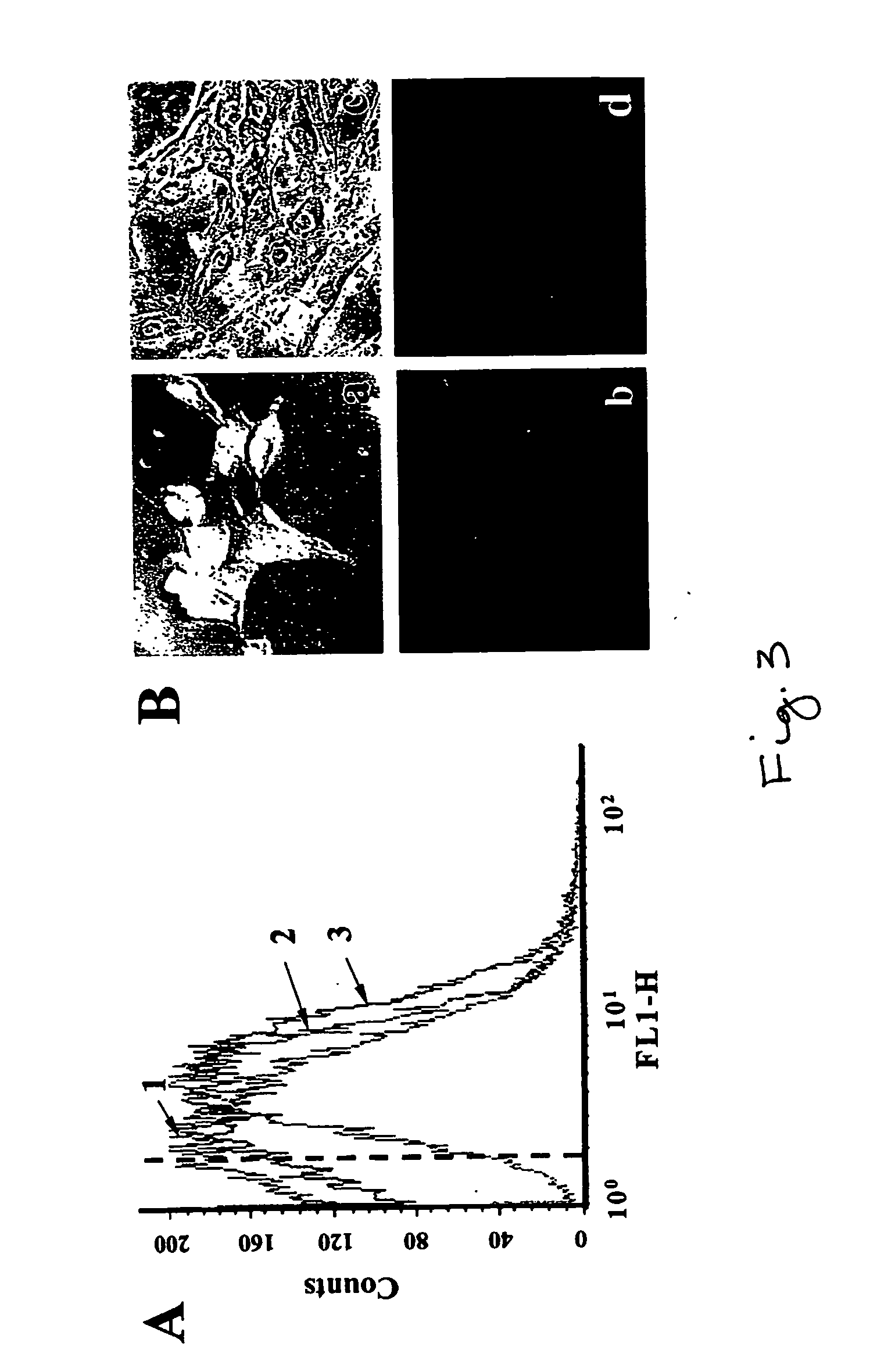Intracellular delivery of therapeutic agents
a technology of therapeutic agents and intracellular delivery, which is applied in the direction of antibody medical ingredients, genetic material ingredients, viruses/bacteriophages, etc., can solve the problem that large pieces of (negatively charged) dna cannot be incorporated into the liposome vesicle, and achieve the effect of minimizing the toxicity of the delivery system and increasing the efficacy of intracellular delivery
- Summary
- Abstract
- Description
- Claims
- Application Information
AI Technical Summary
Benefits of technology
Problems solved by technology
Method used
Image
Examples
example i
Intracellular Trafficking of TATp-Liposomes
[0039] Intracellular trafficking and localization of TATp-liposomes were tested in BT20 cells grown on coverslips in 6-well plates. At approximately 60-70% confluency, cells were incubated with liposomes in a serum-free medium at 37° C. under 6% CO2. The medium was removed and the cells washed with sterile PBS, pH 7.4, after 1, 2, 4, 9 and 24 hr incubation. Coverslips were mounted cell-side down with fluorescence-free glycerol-based mounting medium and viewed by epi-fluorescence microscopy (Nicon Eclipse E400, Nicon Co.) and deconvolution differential interference contrast (DIC) microscopy with pseudo-coloring (Axioplan 2, Zeiss Co.).
[0040] Free FITC-dextran showed only minimal intracellular accumulation in the BT20 cells used (not shown), while 200 nm Rh-labeled TATp-liposomes loaded with FITC-dextran rapidly translocated into these cells. Typical patterns of time-dependent distribution of TATp-liposomes inside individual cells are shown...
example ii
Preparation of TATp-Liposome / Plasmid Complexes
[0042] Liposomes for complexation with DNA did not contain any fluorescent labels, but did contain up to 10 mol % of the cationic lipid DOTAP to enhance plasmid association. Liposomes from a mixture of PC, Ch, DOTAP, and pNP-PEG-PE (7:3:1:0.05 molar ratio) were prepared as above, and incubated with the pEGFP-N1 plasmid overnight at 4° C. In a typical case, the liposome / plasmid complex containing a total of 2 mg lipid and 200 μg DNA was incubated with an appropriate amount of TATp overnight at pH 8.5 in a borate buffer, and purified by gel filtration on Bio-Gel A-1.5. The post-column fraction was subjected to agarose gel electrophoresis to test for the presence and intactness of the plasmid in complex with the liposomes. To determine DNA content, the post-column TATp-liposome / plasmid complex-containing fraction was treated with Triton X-100 for 1 hour at 37° C. to release the plasmid from the complex, and then subjected to agarose gel el...
example iii
[0044] NIH / 3T3 or H9C2 cells grown to 60-70% confluency on coverslips were incubated in serum-free media with TATp-liposome / plasmid complexes or liposome / plasmid complexes (in the quantity required to deliver 5 μg DNA per 200,000 cells at DNA concentration of 0.3 μg / μl of added liposomal suspension) for 4 hrs at 37° C. under 6% CO2. The same quantity of Lipofectin® / pEGFP-N1 complex with the same lipid-to-DNA ratio was used as the control. After incubation, the medium was removed and the cells were washed twice with sterile PBS and re-incubated with complete DMEM containing 10% FBS for 72 hrs. For flow cytometry (FACScan™, Becton Dickinson Biosciences), NIH / 3T3 cells were grown in 25 cm2 flasks and fixed in 4% paraformaldehyde. GFP expression was visualized by light microscopy and epifluorescence microscopy using a FITC filter.
[0045] The results of the treatment of NIH / 3T3 fibroblasts and H9C2 cardiomyocytes with TATp-liposome / pEGFP-N1 complexes are presented i...
PUM
| Property | Measurement | Unit |
|---|---|---|
| mol % | aaaaa | aaaaa |
| mol % | aaaaa | aaaaa |
| mol % | aaaaa | aaaaa |
Abstract
Description
Claims
Application Information
 Login to View More
Login to View More - R&D
- Intellectual Property
- Life Sciences
- Materials
- Tech Scout
- Unparalleled Data Quality
- Higher Quality Content
- 60% Fewer Hallucinations
Browse by: Latest US Patents, China's latest patents, Technical Efficacy Thesaurus, Application Domain, Technology Topic, Popular Technical Reports.
© 2025 PatSnap. All rights reserved.Legal|Privacy policy|Modern Slavery Act Transparency Statement|Sitemap|About US| Contact US: help@patsnap.com



